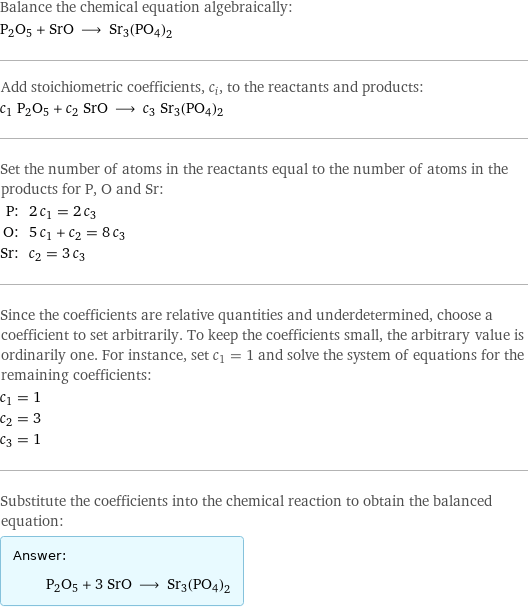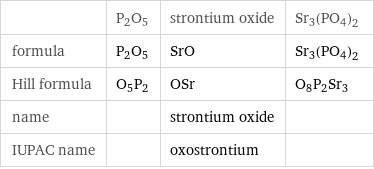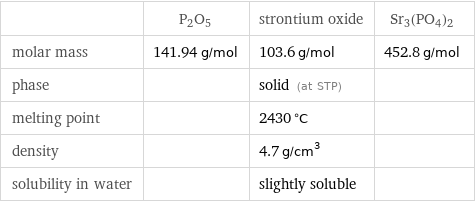Input interpretation

P2O5 + SrO strontium oxide ⟶ Sr3(PO4)2
Balanced equation

Balance the chemical equation algebraically: P2O5 + SrO ⟶ Sr3(PO4)2 Add stoichiometric coefficients, c_i, to the reactants and products: c_1 P2O5 + c_2 SrO ⟶ c_3 Sr3(PO4)2 Set the number of atoms in the reactants equal to the number of atoms in the products for P, O and Sr: P: | 2 c_1 = 2 c_3 O: | 5 c_1 + c_2 = 8 c_3 Sr: | c_2 = 3 c_3 Since the coefficients are relative quantities and underdetermined, choose a coefficient to set arbitrarily. To keep the coefficients small, the arbitrary value is ordinarily one. For instance, set c_1 = 1 and solve the system of equations for the remaining coefficients: c_1 = 1 c_2 = 3 c_3 = 1 Substitute the coefficients into the chemical reaction to obtain the balanced equation: Answer: | | P2O5 + 3 SrO ⟶ Sr3(PO4)2
Structures

P2O5 + ⟶ Sr3(PO4)2
Names

P2O5 + strontium oxide ⟶ Sr3(PO4)2
Equilibrium constant
![Construct the equilibrium constant, K, expression for: P2O5 + SrO ⟶ Sr3(PO4)2 Plan: • Balance the chemical equation. • Determine the stoichiometric numbers. • Assemble the activity expression for each chemical species. • Use the activity expressions to build the equilibrium constant expression. Write the balanced chemical equation: P2O5 + 3 SrO ⟶ Sr3(PO4)2 Assign stoichiometric numbers, ν_i, using the stoichiometric coefficients, c_i, from the balanced chemical equation in the following manner: ν_i = -c_i for reactants and ν_i = c_i for products: chemical species | c_i | ν_i P2O5 | 1 | -1 SrO | 3 | -3 Sr3(PO4)2 | 1 | 1 Assemble the activity expressions accounting for the state of matter and ν_i: chemical species | c_i | ν_i | activity expression P2O5 | 1 | -1 | ([P2O5])^(-1) SrO | 3 | -3 | ([SrO])^(-3) Sr3(PO4)2 | 1 | 1 | [Sr3(PO4)2] The equilibrium constant symbol in the concentration basis is: K_c Mulitply the activity expressions to arrive at the K_c expression: Answer: | | K_c = ([P2O5])^(-1) ([SrO])^(-3) [Sr3(PO4)2] = ([Sr3(PO4)2])/([P2O5] ([SrO])^3)](../image_source/816ae37318889a209964c4dabb2127b3.png)
Construct the equilibrium constant, K, expression for: P2O5 + SrO ⟶ Sr3(PO4)2 Plan: • Balance the chemical equation. • Determine the stoichiometric numbers. • Assemble the activity expression for each chemical species. • Use the activity expressions to build the equilibrium constant expression. Write the balanced chemical equation: P2O5 + 3 SrO ⟶ Sr3(PO4)2 Assign stoichiometric numbers, ν_i, using the stoichiometric coefficients, c_i, from the balanced chemical equation in the following manner: ν_i = -c_i for reactants and ν_i = c_i for products: chemical species | c_i | ν_i P2O5 | 1 | -1 SrO | 3 | -3 Sr3(PO4)2 | 1 | 1 Assemble the activity expressions accounting for the state of matter and ν_i: chemical species | c_i | ν_i | activity expression P2O5 | 1 | -1 | ([P2O5])^(-1) SrO | 3 | -3 | ([SrO])^(-3) Sr3(PO4)2 | 1 | 1 | [Sr3(PO4)2] The equilibrium constant symbol in the concentration basis is: K_c Mulitply the activity expressions to arrive at the K_c expression: Answer: | | K_c = ([P2O5])^(-1) ([SrO])^(-3) [Sr3(PO4)2] = ([Sr3(PO4)2])/([P2O5] ([SrO])^3)
Rate of reaction
![Construct the rate of reaction expression for: P2O5 + SrO ⟶ Sr3(PO4)2 Plan: • Balance the chemical equation. • Determine the stoichiometric numbers. • Assemble the rate term for each chemical species. • Write the rate of reaction expression. Write the balanced chemical equation: P2O5 + 3 SrO ⟶ Sr3(PO4)2 Assign stoichiometric numbers, ν_i, using the stoichiometric coefficients, c_i, from the balanced chemical equation in the following manner: ν_i = -c_i for reactants and ν_i = c_i for products: chemical species | c_i | ν_i P2O5 | 1 | -1 SrO | 3 | -3 Sr3(PO4)2 | 1 | 1 The rate term for each chemical species, B_i, is 1/ν_i(Δ[B_i])/(Δt) where [B_i] is the amount concentration and t is time: chemical species | c_i | ν_i | rate term P2O5 | 1 | -1 | -(Δ[P2O5])/(Δt) SrO | 3 | -3 | -1/3 (Δ[SrO])/(Δt) Sr3(PO4)2 | 1 | 1 | (Δ[Sr3(PO4)2])/(Δt) (for infinitesimal rate of change, replace Δ with d) Set the rate terms equal to each other to arrive at the rate expression: Answer: | | rate = -(Δ[P2O5])/(Δt) = -1/3 (Δ[SrO])/(Δt) = (Δ[Sr3(PO4)2])/(Δt) (assuming constant volume and no accumulation of intermediates or side products)](../image_source/49205d47fbd03a44dadada2d0f62c551.png)
Construct the rate of reaction expression for: P2O5 + SrO ⟶ Sr3(PO4)2 Plan: • Balance the chemical equation. • Determine the stoichiometric numbers. • Assemble the rate term for each chemical species. • Write the rate of reaction expression. Write the balanced chemical equation: P2O5 + 3 SrO ⟶ Sr3(PO4)2 Assign stoichiometric numbers, ν_i, using the stoichiometric coefficients, c_i, from the balanced chemical equation in the following manner: ν_i = -c_i for reactants and ν_i = c_i for products: chemical species | c_i | ν_i P2O5 | 1 | -1 SrO | 3 | -3 Sr3(PO4)2 | 1 | 1 The rate term for each chemical species, B_i, is 1/ν_i(Δ[B_i])/(Δt) where [B_i] is the amount concentration and t is time: chemical species | c_i | ν_i | rate term P2O5 | 1 | -1 | -(Δ[P2O5])/(Δt) SrO | 3 | -3 | -1/3 (Δ[SrO])/(Δt) Sr3(PO4)2 | 1 | 1 | (Δ[Sr3(PO4)2])/(Δt) (for infinitesimal rate of change, replace Δ with d) Set the rate terms equal to each other to arrive at the rate expression: Answer: | | rate = -(Δ[P2O5])/(Δt) = -1/3 (Δ[SrO])/(Δt) = (Δ[Sr3(PO4)2])/(Δt) (assuming constant volume and no accumulation of intermediates or side products)
Chemical names and formulas

| P2O5 | strontium oxide | Sr3(PO4)2 formula | P2O5 | SrO | Sr3(PO4)2 Hill formula | O5P2 | OSr | O8P2Sr3 name | | strontium oxide | IUPAC name | | oxostrontium |
Substance properties

| P2O5 | strontium oxide | Sr3(PO4)2 molar mass | 141.94 g/mol | 103.6 g/mol | 452.8 g/mol phase | | solid (at STP) | melting point | | 2430 °C | density | | 4.7 g/cm^3 | solubility in water | | slightly soluble |
Units
